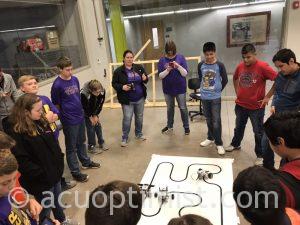The Department of Engineering and Physics conducted the fourth annual Line-Following Robotics Competition on Nov. 10 for middle school and high school participants.
The first Line-Following Robotics Competition took place at Wylie Junior High School in the Fall of 2015 and was organized by Louis Heidema, an airman stationed at Dyess Air Force Base.
Dr. Darby Hewitt, assistant professor of engineering and physics, took a group of Engineering and Physics students to compete in the open division contest. Dr. Hewitt approached Heidema and offered to host the contest the following year. The Engineering and Physics department has hosted the event in Bennett Engineering and Physics Lab ever since.
The Fourth Annual Line-Following Robotics Competition was held Saturday, Nov. 10. The competition required no entry fee and was open to all ages. The purpose of the competition was to encourage interest in robotics, programming and design work.

Participants at Fourth Annual Line-Following Robotics Competition held at Bennett Engineering and Physics Lab. (Photo by Matt Fryer)
The competition consisted of a basic course and, for the first time, an advanced course for participants. The Maker Lab assisted in building the tracks. The basic course had three divisions: Junior Division (7th grade and younger), Senior Division (7th grade and older) and Open Division (anyone beyond high school). There were 47 total participants in the competition.
Matt Fryer, fill-in for director of the competition and currently deployed Heidema, said the turnout doubled the number of participants.
“I’d say the big supporters with the biggest turnout were the kids from Merkel,” Fryer said. “Their robotics club brought a bus. They had about 17 kids participate and four teams in total.”
The competition began at noon and the races started at 1 p.m. The track features and goals of the races needed for the construction of the robots were made known to participants prior to the competition.
There were four basic tracks for the participants to rotate through with smooth, circular turns that were no more than 70-degree angles. The advanced tracks were made up of 90-degree turns and breaks in lines.
Fryer said some of the more advanced robots were able to measure light reflectivity to follow the lines as quickly and efficiently as possible.
Dr. Hewitt put together awards and certificates for the conclusion of the competition.
“There really weren’t any strict requirements,” Hewitt said. “It’s kept that way so that there aren’t any restrictions on who can compete. A lot of this is about making a competition like this available to as many students as possible. Some kids can’t afford to pay an entry fee, or if you limit it to one type of robot system then you might limit people who can’t afford that. The idea here was to make a competition that’s as open-ended as possible, so there is a way for anyone to compete.”
ACU had 14 students from the Engineering and Physics department who volunteered to clean up, set up, judge and lead groups for the competition.
Christine Case, junior engineering major from Fort Worth, said she received an email from Dr. Hewitt about the volunteering opportunity and decided she had free time to sign up.
“I think that it was good for [the kids] to see older people that are choosing their future in the STEM career field,” Case said. “I was talking to them and they seemed like they would want to do this for the rest of their lives. They obviously get the programming skills that they need and then coming to a college campus, I think is definitely a good experience. Something that I never got to do in middle school.”
